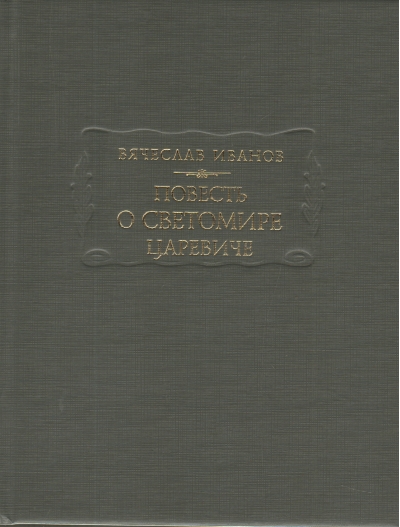The Tale of Tsarevich Svetomir
69.99 €
The only thing available 1
"The Tale of Svetomir the Tsarevich" - the last major work of the symbolist poet and thinker Vyacheslav Ivanovich Ivanov (1866-1949), his magnum opus, created during the Italian emigration (1928-1949). The work is stylized as a medieval tale or hagiography and permeated with fairy tale and legendary motifs, and is considered one of the outstanding works of Russian literature of the twentieth century.
"Narrative" is oriented to such ancient genres as chronicle, non-canonical legend, apocryphal, partly Western chivalric novel. The story is told on behalf of a "monk elder"; as it should be in medieval literature, this elder is anonymous and subject to a strictly developed verbal etiquette. It is as if we are looking at an Old Russian monument, but at the same time it is as if we are translating this monument into a more modern language. It is difficult to approach it, partly because its verbal originality hides the semantic laws of its construction from immediate view. "The Tale" is multilayered. Depending on the reader's attitude, it can be understood as a fairy tale, an adventure epic, a quasi-historical novel, or a theological treatise. It can be classified as a typical example of neo-mythological art of our time, but it is comparable not to the "anti-myths" of Joyce and Kafka, but to Thomas Mann's Joseph and His Brothers or Hermann Hesse's Pilgrimage to the Land of the East - that is, to books of a postmodern, constructive, synthesizing kind. At the same time, the Tale is not complete. Ivanov considered myth-making - passing into theurgy - the basis and purpose of all great art. He more consistently than other Russian Symbolists turned to mythological models: in the first half of life, under the obvious influence of Nietzsche - to the ancient mythology of the suffering god, later - to what can be called Christian mythology (as opposed to Christian theology). The limit of his search was a certain synthetic worldview, in which pagan myths turned out to be a vague and approximate, but in their own way deep and effective anticipation of Christian dogmas. The story is printed on the basis of manuscripts preserved in the Roman Archive of Vyacheslav Ivanov. For the first time, early drafts and plans, as well as variants from the rough editions, are published. As is customary in the series "Literary Monuments", the volume includes detailed articles, exhaustive scientific commentaries, "The main dates of the life and work of Vyacheslav Ivanov". The articles reconstruct the creative history of the story, its literary context and artistic nature. The commentaries reveal the complex subtexts of the work, in particular, the layer of esoteric, Kabbalistic and Gnostic symbolism. The edition includes many unique visual materials from Vyacheslav Ivanov's Roman archive.
"Narrative" is oriented to such ancient genres as chronicle, non-canonical legend, apocryphal, partly Western chivalric novel. The story is told on behalf of a "monk elder"; as it should be in medieval literature, this elder is anonymous and subject to a strictly developed verbal etiquette. It is as if we are looking at an Old Russian monument, but at the same time it is as if we are translating this monument into a more modern language. It is difficult to approach it, partly because its verbal originality hides the semantic laws of its construction from immediate view. "The Tale" is multilayered. Depending on the reader's attitude, it can be understood as a fairy tale, an adventure epic, a quasi-historical novel, or a theological treatise. It can be classified as a typical example of neo-mythological art of our time, but it is comparable not to the "anti-myths" of Joyce and Kafka, but to Thomas Mann's Joseph and His Brothers or Hermann Hesse's Pilgrimage to the Land of the East - that is, to books of a postmodern, constructive, synthesizing kind. At the same time, the Tale is not complete. Ivanov considered myth-making - passing into theurgy - the basis and purpose of all great art. He more consistently than other Russian Symbolists turned to mythological models: in the first half of life, under the obvious influence of Nietzsche - to the ancient mythology of the suffering god, later - to what can be called Christian mythology (as opposed to Christian theology). The limit of his search was a certain synthetic worldview, in which pagan myths turned out to be a vague and approximate, but in their own way deep and effective anticipation of Christian dogmas. The story is printed on the basis of manuscripts preserved in the Roman Archive of Vyacheslav Ivanov. For the first time, early drafts and plans, as well as variants from the rough editions, are published. As is customary in the series "Literary Monuments", the volume includes detailed articles, exhaustive scientific commentaries, "The main dates of the life and work of Vyacheslav Ivanov". The articles reconstruct the creative history of the story, its literary context and artistic nature. The commentaries reveal the complex subtexts of the work, in particular, the layer of esoteric, Kabbalistic and Gnostic symbolism. The edition includes many unique visual materials from Vyacheslav Ivanov's Roman archive.
See also:
- All books by the publisher
- All books by the author
- All books in the series Literary monuments




